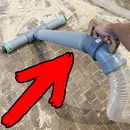Introduction: Simple Pop Out Router Table
Router is right after table saw the most important tool in workshop. Plunge router offers plenty of ways to modify wood to desired shape. Same thing upside down attached to a table widens the possibilities even more.
Follow me as I show you how I built my router table that can still be used as plunge router without any annoying plate changes.
Once again this is a part of a bigger build where I modify a contractor table saw to be something more multifunctional. Here is what I did with the other end of the table. Hit the follow button if you want to see how it all turns out!
Only material that you need for this build is a small rectangular piece (2 mm thick) of sheet metal. I found a scrap piece at my local metal distributor and the guy there was kind enough to give it to me for free. For the fine adjustment I used few furniture bolts.
For the tools I used few power tools drill bits and counter sink bit.
As you can see this project is fairly simple but it will add so much to your shop.
Let´s get started!
Step 1:
To start with I took a grinder and removed some of the rust on the plate and with metal file I smoothed the edges.
I took a bi-metal hole saw and drilled a hole in the middle. I checked that the hole is big enough for my widest router bit. I still made it little bigger in case I were ever to obtain even wider bit.
On the table I marked the center point and with V-bit I could align the router exactly in the middle. I traced and cut out the hole. From the under side I marked the screw hole positions using the original bottom plate.
Then I drilled and counter sank the holes on a drill press.
Step 2:
I have layer of 8mm thick MDF on my workbench. If you have a solid workbench you can use your router to make the resess for the metal plate. Just be sure to use straight edge when routing to get finer results.
Using my jig saw I removed some material on the edges (see pictures). This was that I could easily pop the router out and use it as a normal plunge router. Bigger bottom plate gives more stability. Changing back to the normal bottom plate is just a matter of unscrewing six screws.
For the fine height adjustment I used furniture bolts. I added one to each corner as well as one between the corners. This method allowed me to get the router absolutely flush with the rest of the table.
Step 3: The End
Works like a charm!
I still need to modify my fence so I could router right at the edge of a piece. And of course for the safety I need to build a pair of push pads.
With this simple build I have widened the routing possibilities and at the same time increased the work flow.
I hope you like it! If you have any questions feel free to ask them in the comments.
Cheers!













